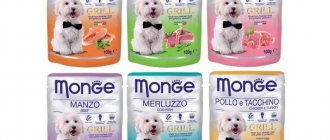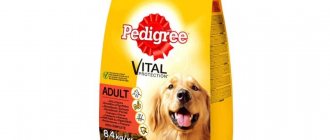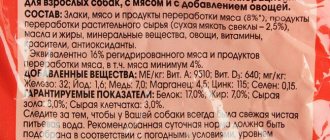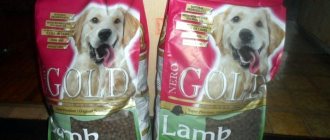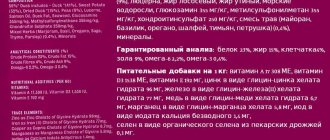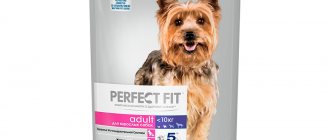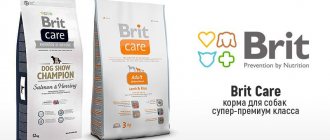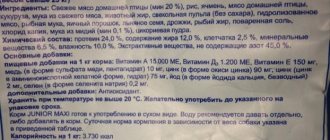Food for dogs with kidney failure is an important part of treatment. Without limiting phosphorus and protein in the diet, improvement is impossible. The principles of creating a diet for kidney disease are the same for everyone. But different products can be selected to meet these rules.
Veterinarians rarely delve into the composition of “medicinal” feeds, focusing on the manufacturer’s recommendations. The owners, in turn, suspect veterinarians of paid loyalty to one or another brand.
Hand on heart, no matter how many veterinary diets I prescribe, the world giants have not yet paid me a penny. “Three pillars” - Royal Canin, Proplan and Hills are prescribed for one reason: they are available, they have accumulated a lot of experience in using their products. Previously, Eukanuba food was actively used, but they no longer supply therapeutic diets to Russia.
I studied in detail the composition of these and other, rarer foods that veterinarians recommend for dogs with kidney damage. I hope this information will help you make your own choice.
Older pets may need a special diet
If possible, the therapeutic diet is initially prescribed the same brand that the pet was previously eating. But often dogs are kept on homemade diets or food that does not have veterinary diets. Then the prescription may look like this: dog food for kidney failure (Renal) from any company (if your doctor does not have his own “favorite” on the market of therapeutic diets).
Author of the article: Olga Shiltsova, practicing veterinarian, author of the books “Dachshund of Fate” and “Tails of Fortune”
Purina Pro Plan NF Renal Function
The Pro Plan company is owned by such an industry giant as Nestle (USA). This corporation primarily produces products for people. Food processing waste is likely used in animal feed factories. Purina has factories in many countries. If previously in Russia feed was mainly sold produced in France or Italy, now it is also produced at a plant in the Kaluga region.
ProPlan NF food contains:
- 13% protein;
- 14% fat;
- 2% fiber;
- 0.4% phosphorus.
Pros of Proplan Renal food:
- Easy to buy (available in stores);
Disadvantages of Proplan Renal food:
- Unreasonably high cost (700-800 RUR/kg);
- Extremely low protein levels, even for a renal diet;
- At the same time, phosphorus is 0.4% (there are diets with a phosphorus content of 0.25-0.35%);
- Flavoring of unknown origin in the composition;
- Powdered eggs are not the same as “dry whole eggs”, they are made from waste from egg processing;
- Animal fat - the formulation allows the use of waste from slaughterhouses (corpses, sick animals) and even from fur farms.
- Poor amino acid composition;
- Low caloric intake can lead to progressive weight loss in a dog with kidney disease.
Foods to Avoid
Table scraps are generally not recommended for any dog. Some foods can be harmful and toxic even for humans.
Healthy dogs can safely eat some table scraps, such as lean meats, soft rice or pasta, and some fruits and vegetables. However, dogs with chronic kidney disease are an exception.
Some human foods contain too much sodium and/or protein to be safe for dogs with CKD. Ask your veterinarian if there are any human foods you can feed to your pets that do not cause kidney harm.
Foods and treats designed for healthy dogs are not necessarily suitable for dogs with chronic kidney disease. Ask your veterinarian which foods and treats are appropriate for your pet. Your doctor can help you find treats made with kidney medicinal formula.
It is also important to ensure that your dog does not accidentally eat foods that could be harmful to him. You may need to feed other pets separately to keep their food out of reach.
Cat food can be especially harmful to a dog's health because it is typically high in protein and also tends to upset the stomach, leading to diarrhea and dehydration (a dangerous situation for a pet with chronic kidney disease).
Hill's k/d Kidney Care
The world's first medicinal diet was formulated by veterinarian Mark Morris for a dog with kidney disease in the 1930s. This is where the history of Hill's began. Since 1976, the brand has been owned by Colgate-Palmolive (USA). Hill's food is extremely popular all over the world. Factories are located in the USA, the Netherlands and the Czech Republic.
In March 2022, something bad happened: Hills recalled a batch of their food because it contained a toxic dose of vitamin D. This led to the death of several animals. The food included a k/d diet. But the manufacturer’s behavior in that situation was impeccable: they admitted their mistake and removed all the food from the shelves, despite the losses.
Hills k/d food contains:
- 15% protein;
- 21.1% fat;
- 3.6% fiber;
- 0.24% phosphorus.
Advantages of Hills k/d food:
- Easy to find on sale, including in veterinary clinics;
- Really low phosphorus and moderately low protein;
- Whole egg as a source of protein;
- Protein hydrolysate makes the food attractive to dogs;
- Fish oil as a source of Omega-3 fatty acids.
Disadvantages of Hills k/d food:
- The relatively high percentage of fat makes the food an unsuitable diet for dogs that, in addition to kidney failure, suffer from liver or pancreas disease;
- Poor composition (there is no meat in the composition);
- High cost (600-800 RUR/kg).
Let's sum it up
For treatment to have a quick effect, you need to adjust your pet’s diet and reduce the amount of meat in it. It is worth giving up excessively fatty foods, but vegetable oils will not cause harm. If there are problems with the kidneys, you should include as many vegetables as possible in your daily diet, for example, potatoes, carrots. They are easier to digest, making it easier for your dog’s body to absorb the nutrients.
You also need to choose a special medicinal food. Dogs often don’t like them, so it’s better not to buy a batch at once, but to conduct an experiment by purchasing several foods of different brands and types. If your dog refuses to eat even this way, consult your veterinarian: dogs with kidney problems should never go hungry.
Royal Canin Renal RF14
Royal Canin is the most widespread brand of pet food in Russia. Mainly thanks to a wide advertising campaign. Royal Canin is everywhere - in clinics and pet stores. The brand is owned by a true global giant – the MARS company.
The history of the company began in France in 1967, the founder was veterinarian Jean Katari. Previously (and still today) Royal Canin food was imported from France. Since 2004, food has been produced in Russia.
Royal Canin Renal food contains:
- 14% protein;
- 18% fat;
- 2.4% fiber;
- 0.2% phosphorus.
Advantages of Royal Canin Renal food:
- Record low phosphorus levels;
- Good palatability (appetizing enough for dogs);
- Fish oil (lots of Omega-3 fatty acids);
- Easy to buy, always in stock.
Disadvantages of Royal Canin Renal food:
- In addition to rice and corn, it contains a large amount of gluten (gluten), which means that most of the protein in the declared 14% is of plant origin;
- The composition does not contain meat or eggs, and there is no addition of synthetic essential amino acids;
- Cost 600-700 RUR/kg.
STAY IN TOUCH
What else is important to know
Here are a few more important points from the document entitled “Standard Operating Procedure: Procedure for Vaccination against COVID-19 with the EpiVacCorona Vaccine in Adults”:
— On the day of vaccination, the doctor conducts a survey and examination of the patient with mandatory thermometry. At temperatures above 37 °C, vaccination is not carried out.
- Patients receiving immunosuppressive therapy (that is, drugs that suppress the immune system) and patients with immunodeficiency may not develop an adequate immune response.
— If the patient has had contact with COVID-19 patients within the last 14 days or if there are symptoms of infection during this period, a referral is issued for a PCR test for COVID-19 or for a rapid test for the presence of coronavirus SARS-CoV-2 (clause 7.3.2 of the document ).
— Those who have recovered from COVID-19 and persons who have positive test results for the presence of immunoglobulins (that is, antibodies) of classes G and M to the SARS-CoV-2 virus are not vaccinated (clause 7.3.3 of the document).
Monge Vet Solution Renal
The Monge Group began as a family business in 1963. It is now the largest pet food manufacturer in Italy. The new plant, equipped with the most modern equipment, was opened in 2009 and produces more than 127 tons of feed per year.
Monge Renal food contains:
- 19% protein
- 19% fat
- 3.7% fiber
- 0.36% phosphorus
Advantages of Monge Renal food:
- Chicken meat as a source of protein;
- The specificity in the names of the ingredients indicates their high quality (not “animal” or “poultry” fat, but “duck fat” and “chicken fat”);
- A high percentage of fat makes the food nutritious and attractive in taste;
- Added essential amino acids;
- High content of Omega-3 fatty acids;
- Contains camellia sinensis extract. In Russian, this is green tea extract, a proven source of polyphenols (catechins). Catechins reduce damage to the renal epithelium, lower blood pressure and improve renal circulation.
- Superoxide dismutase, SOD (source – melon pulp) – a powerful antioxidant;
- Xylooligosaccharides promote the development of bifidobacteria and lactobacilli in the intestines, suppressing pathogenic microflora.
Cons of Monge Renal food:
- Controversial protein levels (19% is slightly higher than other foods for dogs with kidney failure);
- High cost (about 750 RUR/kg for 2 kg packaging, 550 RUR/kg for 12 kg packaging);
- Difficult to buy, not available everywhere.
Rules for selecting food for dogs with kidney disease
Food for dogs with kidney failure must meet a whole list of standards. Moreover, they concern not only the concentration of certain ingredients, but also the heat treatment process and the regularity of feeding. However, you need to study them all. This is the only way to determine whether the food will harm the dog. The most important rules are:
- Check the composition of the feed. It should contain a minimum amount of salt and phosphorus, which are known to have a destructive effect on mucous surfaces. But minerals and vitamins must be present in it in sufficient quantities.
- Select food based on the stage of disease of the excretory system. There are gradations for degrees 1-3 and 4, and there are both liquid and solid foods: you can choose based on your pet’s preferences.
- Preferably, the therapeutic diet should be produced by the company that created the dry food used on an ongoing basis before the illness. This way the animal will get used to it faster. But if you did not feed your pet a super-premium or holistic diet, it is better to switch to products from a different brand.
Kidney diseases are incurable. Therefore, it is necessary to maintain the correct nutrition system for the rest of your pet’s life. Perhaps it will be possible to pamper him a little with goodies, but only if the urine test results are satisfactory. So it’s better to choose food that you can always buy again.
Farmina Vet Life Renal
Farmina Pet Foods is an Italian-owned company with factories in Italy, Serbia and Brazil. It has been producing food for small pets since 1999; it appeared on the Russian market in 2012.
Farmina Renal food contains:
- 13.3% protein
- 15% fat
- 1.4% fiber
- 0.25% phosphorus
Advantages of Farmina Renal food:
- Low levels of phosphorus and protein can improve the condition of animals with chronic renal failure;
- Whole eggs as a source of protein;
- Fish oil as a source of fatty acids;
- The relatively meager composition is compensated by a rich vitamin-mineral complex and the addition of essential amino acids to the diet;
- Consistently high quality.
Disadvantages of Farmina Renal food:
- Proteins and fats are not enough even for a renal diet;
- There is no meat in the composition;
- Not available everywhere, it can be difficult to buy;
- Cost 600-700 RUR/kg.
Signs of the disease
Some symptoms that indicate a dog is developing kidney failure may be similar to other diseases. These include:
- lethargy, apathy;
- lack of appetite.
But there are other signs that specifically indicate kidney failure:
- strong thirst;
- frequent urination;
- smell of acetone from the mouth.
Moreover, the combination of two symptoms - thirst and frequent urination - are the most characteristic of this disease.
Acute renal failure may have the following manifestations:
- vomit;
- diarrhea;
- change in color of mucous membranes;
- swelling.
In the final stage, when the body is heavily poisoned by harmful substances, characteristic symptoms of intoxication appear:
- ulceration of the mucous membrane;
- shiver;
- convulsions.
If you observe similar symptoms in your pet, we recommend immediately contacting a veterinarian to have your dog examined and find out the causes of this condition. Early diagnosis of renal failure is the key to successful treatment and prolongation of the pet’s life.
Advance Veterinary Diets Renal
Advance food is produced by the Spanish company Affinity. She acquired this brand in 2002 (it previously belonged to MARS). Its factories, formerly owned by Purina, are located in Spain and France.
Advance Renal food contains:
- 14.5% protein
- 17.5% fat
- 3% fiber
- 0.3% phosphorus
Advantages of Advance Renal food:
- Low phosphorus and moderate protein;
- Fish oil as a source of omega-3 fatty acids;
- Egg as a source of complete protein;
- Inulin (plant polysaccharide) has a beneficial effect on digestion;
- Manufactured abroad (strict quality control);
- Moderate cost (500-550 RUR/kg)
Disadvantages of Advance Renal food:
- There is no meat in the composition;
- Vague wording “animal fats” and “animal proteins” without specifying the type of animal.
Causes
| Cause | Diseases |
| Genetic problems | Amyloidosis (deposition of abnormal protein in the tissue of internal organs, which leads to difficulty performing their functions); Polycystic disease (many cysts filled with fluid form in the kidney, part of the organ turns into a vesicular formation). |
| Parasitic infestation | Piroplasmosis (caused by hematopoietic parasites of the genus Babesia, which destroy red blood cells and have a toxic effect on the body as a whole); Hemobartenellosis (the pathogen blocks the activity of red blood cells, causing anemia). |
| Infectious diseases | Leptospirosis (caused by leptospira bacteria that affect the kidneys, liver, and circulatory system); Viral hepatitis (a pathogen from the genus adenovirus provokes fever, inflammation of the mucous membranes and gastrointestinal tract, damage to the central nervous system and liver); Carnivore plague (one of the most common and dangerous diseases, causing inflammation of the mucous membranes, malfunction of the central nervous system and other organs); Viral enteritis (the pathogen affects the stomach and intestines, blocks the digestion of food and absorption of nutrients, and also affects the kidneys, heart, liver). |
| Inflammatory diseases | Pyelonephritis (the introduction of bacteria into the kidney tissue provokes the overgrowth of the area with leukocytes, where an inflammatory focus subsequently occurs); Glomerulonephritis (damage to the renal glomeruli, dangerous due to accelerated loss of protein in the urine); Nephrosis (degenerative change in kidney tissue as a whole). |
Also, the development of the disease may be based on congenital underdevelopment of organs, tumor processes, urolithiasis, poisoning with household or medicinal poisons, and salts of heavy metals. Some breeds are more genetically predisposed to developing complications than others.
The disease, depending on the cause of its occurrence, has several varieties:
- Renal. The most common variant is characterized by damage to the kidney tissue itself. Occurs as a result of infection, toxic effects, inflammation.
- Prerenal. It is based on a lack of blood inside the organ, most often a consequence of surgery, dehydration, anesthesia, blood loss, and heat exposure.
- Postrenal. Occurs due to mechanical narrowing of the lumen (stones, tumor, etc.).
Forza10 Renal Active
Food under the Forza10 brand is produced by the Italian company SANYpet (founded in 1996 by veterinarian Sergio Canello). Since 2008, the dry food factory has been located in Italy, and canned food is made in Iceland. In Russia, Forza 10 food appeared only after 2010 and is still a rarity in pet stores.
An unusual solution is to produce granules with active substances (medicinal plants, etc.) at room temperature, then mixing them with the bulk of the dry food.
Forza Renal food contains:
- 14% protein;
- 17% fat
- 2.5% fiber
- 0.28% phosphorus
Pros of Forza10 Renal food:
- Low phosphorus levels with moderately low protein content;
- Protein hydrolysates are used - they are well absorbed and serve as a flavoring agent (making the food attractive to dogs);
- Low sodium content and high potassium content;
- High content of omega fatty acids;
- Full spectrum of B vitamins;
- A complex of medicinal plants with proven effectiveness;
- Suitable not only for kidney patients, but also for dogs with heart failure (these diseases can go hand in hand in older animals);
- Moderate cost (480-600 RUR/kg).
Cons of Forza10 Renal food:
- Can be difficult to purchase (few places have it in stock).
Note: incorrect translation of feed composition has become widespread. Supposedly it contains grapes, while Arctostaphylos uva ursi is bearberry!
Diagnostics
As we have already noted, the primary stage of the disease does not have pronounced symptoms, and it is difficult to determine it using laboratory tests, since the kidneys are still doing their job well, despite the changes that have begun in them.
When the clinical stage approaches, a blood test for urea and creatinine reveals an increase in these indicators, and this is what makes it possible to understand that the dog has diseased kidneys.
If you have even the slightest suspicion that your pet has kidney problems, then you need to periodically take tests to determine the level of urea and creatinine and, if they approach the upper limit of the norm, discuss further actions with your veterinarian.
Which food for dogs with kidney failure to choose?
The good news is that all of the foods listed above “work.” And to choose the best one, I suggest focusing on the phosphorus level.
The phosphorus content in diets is indicated as a percentage, and the second important indicator is the calorie content of the feed. The higher the calorie content, the less food your dog needs. The smaller the total amount of feed, the less phosphorus consumed.
All that remains is to find the food with the lowest phosphorus level and the highest calorie content.
Proplan looks like an outsider - with the lowest calorie content in the feed, the highest level of phosphorus! I would not prescribe this diet if there is an alternative.
The leader remains “Holy Royal,” as Royal Canin is sometimes jokingly and contemptuously called. RC Renal food has the highest caloric content with the lowest phosphorus level. A dog weighing 4 kg needs 80 g of Royal, while Proplan needs 90-95 g per day.
I would recommend using the Royal Canin diet if reducing the level of phosphorus in the diet is critical for the patient. With the additional introduction of B vitamins (in food or by injection), and perhaps some amino acids.
Hill's k/d is in second place - the phosphorus level is not much higher than in Royal Canin, and the calorie content is not much lower - feeding rates are almost the same. Hill's peculiarity is the highest level of fat (21.1%), which is dangerous for the pancreas. But on the other hand, there is 1% more protein than in Royal Canin, and there are eggs in the composition.
Of the remaining ones, Monge Vet Solution Renal is a favorite. This is what I recommend at the initial stage of renal failure. The highest level of protein (19%) with moderate phosphorus content - and an excellent composition, including meat. The food contains medicinal plant extracts, vitamins of all groups (including B vitamins), and essential amino acids.
Forza10 also looks interesting due to its special production technology, excellent composition and complex of medicinal herbs.
I don’t see any point in looking specifically for Farmina or Advance. Good food, but if they are not sold in your city, it is better to find an alternative.
- 1. Fat content of food for dogs with chronic renal failure
- 2. Moderate protein content
- 3. Low phosphorus content
- 4. Carbohydrates
- 5. Other restrictions
- 6. Green tripe
- 7. Apples
- 8. Ryazhenka
- 9. Raw meat bones (BARF)
- 10. Water
- 11. Vitamins and other nutritional supplements for kidney problems
- 12. Some homemade food recipes for dogs with chronic renal failure
Many owners state the fact that their dogs would rather remain hungry than eat ready-made kidney food. In addition, you should not fool yourself into thinking that commercial food will best meet the needs of a sick dog for high-quality and easily digestible food. Therefore, many owners, and with them experienced veterinarians, are inclined towards homemade food for kidney patients.
Here are some basic principles for creating a diet for a dog with chronic kidney disease:
Fat content of food
Fat supplies a large amount of the calories needed because dogs, as carnivores, are designed to get their energy primarily from fat rather than from carbohydrates like humans. With rare exceptions, dogs do not suffer from high cholesterol or other human problems associated with high fat intake. Therefore, the diet of a dog with chronic renal failure should be rich in fats in order to provide it with a sufficient amount of calories even in conditions when it eats little. However, we must remember that excess fat can lead to diarrhea and mucus in the stool, and dogs prone to pancreatitis cannot cope with large amounts of fat. But otherwise, fat is good for your dog. It is important that the increase in fat be gradual to avoid digestive problems and the possibility of pancreatitis. If you notice signs of problems, such as your dog being uncomfortable after eating, vomiting or diarrhea, this means you need to reduce the amount of fat in the diet to a level that your dog can tolerate.
Sources of dietary fat include:
- Fatty Meat - Use the fattiest ground beef you can get. Pork is also rich in fat. Dark meat of chicken and turkey contains more fat than white meat, but poultry meat is low in fat anyway, so if you feed chicken or turkey, include the skin as well. Beef contains less phosphorus than chicken. Lamb and turkey occupy an intermediate position.
— Use whole milk, yogurt, homemade cheese (cottage cheese), ricotta , etc. - since these foods are rich in phosphorus, they should be given in moderation, but if given, then these should be the fattest varieties. If your dog doesn't like the regular variety, try goat's milk yogurt for a taste.
- Egg yolks are rich in fat, but also very rich in phosphorus, so they should be given in moderation.
- Fat can come in the form of bacon fat (no or low sodium), chicken fat , butter (use unsalted if your dog has high blood pressure).
— In general, vegetable oils are not recommended as sources of fat . They are rich in omega-6 fatty acids, which are harmful for dogs with kidney disease. Instead of vegetable oils, use fish oil, such as salmon body oil or EPA (NOT to be confused with cod liver oil). Flaxseed oil, although richer in omega-3 fatty acids than most vegetable oils, is also rich in omega-6 and is therefore not recommended. Olive oil can probably be used in small quantities due to the fact that it mainly contains omega-9, which is not known to affect kidney function.
IMPORTANT: A dog with chronic renal failure should not starve. Therefore, when choosing between “junk” food and the harm from an empty stomach, make a choice in favor of a dog that has eaten.
Moderate protein content
How much protein to feed is still a topic of debate, but there is no need for a low protein diet unless your dog has uremia.
Traditional recommendations for dogs with mild to moderate chronic kidney disease are 2.0 to 2.2 g/kg protein, or about 1 g per 450 g body weight. However, more modern studies note that, in fact, the daily protein requirement in dogs with chronic renal failure is slightly higher than in healthy dogs - more than 3 - 3.5 g per 0.5 kg of weight, and if you do not go beyond the desired phosphorus limit, there is no need to worry too much about excess protein.
Eggs provide the highest quality protein, but egg yolk is very rich in phosphorus, so it is best to feed 2 to 3 whites for every yolk you feed your dog. Also, although raw food is better for dogs than cooked food, boiled egg whites are thought to be better digestible.
Raw or cooked meat is another rich source of protein. Green tripe can be an excellent food for dogs with kidney failure. The lowest quality protein is found in processed meats - commercially prepared foods, and grains.
Research over the past 10-15 years has shown that feeding a dog low protein food is only necessary when he is uremic. This means a BUN level of more than 28 mmol/L, a creatinine level of more than 398 µmol/L, and the dog exhibiting symptoms such as vomiting, nausea, lack of appetite, signs of ulcers and lethargy, which are caused by the formation of nitrogen in the blood. But even in this case, food low in protein will not prolong the life of the dog, but it will improve its well-being. If your dog does not have uremia, then it is wise to feed a moderate amount of very high quality protein.
The article Diet Problems in Dogs (by Dr Michael Richards, DVM) states: “High quality proteins are those with the most complete amino acid composition the body needs to function. Animal proteins - meat, milk and eggs - are of higher quality than plant proteins. This is because the animal that is the source of these products has already produced the necessary proteins, and they are in the right combination. Therefore, for example, cottage cheese is considered a higher quality source of protein than soybeans. However, some amino acids, such as taurine, are heat sensitive, which is one reason why raw meat is considered a better source of protein than cooked meat."
Low phosphorus content
It has been experimentally proven that a diet low in phosphorus is beneficial for dogs with kidney disease. The NRC (National Research Council) nutritional guide recommends feeding a dog with advanced renal failure no more than 22.25 mg/kg phosphorus per day . For dogs with an initial stage, the amount of phosphorus can be up to 60 mg/kg. Low phosphorus feeds contain 15 to 40 mg/kg. In general, foods high in phosphorus include bones, dairy products, fish (with bones), organ meats, and egg yolks . This does not mean that these foods should not be fed at all, since these foods are important components of a complete diet, but they should be given in moderation. Also pay attention to the phosphorus content of the grains and vegetables you feed. The basis for the dosage of the daily amount of phosphorus that should be given is the range of 15-40 mg/kg and 60 mg/kg for the early stages (the more advanced the disease, the less phosphorus should be given) - see table.
| Dog weight | Daily phosphorus intake depending on the stage of chronic renal failure | ||
| initial | average | heavy | |
| 4.5 kg | 272 mg | 182 mg | 68 mg |
| 11 kg | 682 mg | 455 mg | 170 mg |
| 23 kg | 1364 mg | 900 mg | 340 mg |
| 34 kg | 2045 mg | 1364 mg | 511 mg |
| 46 kg | 2727 mg | 1818 mg | 680 mg |
Carbohydrates
Dogs, from a nutritional point of view, do not need carbohydrates, but in order to reduce phosphorus in the diet, it makes sense to feed 50% of the food in the form of carbohydrates. That is, the goal is to add calories without adding excess phosphorus. Grains such as semolina, rice (gluten, small grain) and vegetables such as potatoes, sweet potatoes, pumpkin and zucchini work well for this.
-Vegetables must be either cooked or pureed in a juicer, food processor, or blender so that they can be digested by the dog. Cooking removes phosphorus (as well as potassium and magnesium), meaning this would be the best form of cooking for dogs with kidney failure, but cooking also destroys vitamins. Boiling or steaming removes more phosphorus than baking, unless you also give your dog the water in which the food was boiled. Please note that celery, parsley and dandelion leaves have a diuretic effect, which is not desirable for dogs with kidney failure. Celery is also high in sodium. Dogs with arthritis should avoid white potatoes, tomatoes, eggplant and peppers. Otherwise, boiled potatoes will be a good source of carbohydrates. Cabbage is useful for peptic ulcers, which are typical of kidney disease.
Phosphorus content in vegetables (the number of mg per 100 g of product is indicated in brackets): boiled sweet potatoes (32), boiled white potatoes (40), pumpkin (44), boiled squash (19), acorn squash (27 ), butternut squash (27), torticollis squash (32), spaghetti squash (14), zucchini (32), asparagus (56), beets (40), broccoli (66), carrots (44), Cauliflower (44), Celery (25), Collard Greens (10), Dandelion Leaves (66), Endive Salad (28), Green Beans (19-38), Green Peppers (19), Artichoke ( 78), kale (56), parsley (58), parsnips (71), peas (77-117), red cabbage (42), lettuce (45), tomato (24), watercress ( 60).
— Fruits that can be given to a dog with chronic renal failure (the amount of phosphorus in mg per 100 g of product is indicated in brackets) : apple (7), avocado (41), banana (20), cantaloupe (17), cranberry (9), cucumber (20), mango (11), peach (12), pear (11), pineapple (7). To digest, fruits do not need to be heat treated or crushed into a puree. Colorful fruits such as papaya and mango are especially beneficial for dogs with arthritis. Bananas and pumpkin are very rich in potassium.
Important: Avoid grapes and raisins, because... According to recent research, there is a link between the consumption of these foods in dogs and kidney disease. Excess fruit can cause loose stools.
— Cereals : if you feed cereals, then stick to those that are low in phosphorus (hereinafter in parentheses is the amount of phosphorus per 100 g of boiled cereal). For example, white rice (33), semolina (12), rice flakes (17), malt flakes (10) - contain little phosphorus. On the contrary, brown rice (77), millet (100), oatmeal (76), and pearl barley (54) are rich in phosphorus. For flavor and calories, try adding butter, meat “juice” or fat, and cook with broth and gravy rather than water (no salt).
- Honey : Natural honey is beneficial for all dogs and can also be consumed by dogs with kidney problems. The phosphorus content in honey is insignificant.
Other restrictions
Most other dietary restrictions depend on your dog's individual needs. For example, a dog with chronic renal failure may have low or high blood potassium levels. If potassium is high, you need, for example, to reduce its amount in food (bananas, pumpkin, potatoes, pears, sardines, kiwi, beets, yogurt, zucchini, carrots, celery, broccoli are rich in it). On the contrary, if a dog's potassium levels are too low, potassium salts should be given. If your dog has high blood pressure, which is common with kidney disease, you should reduce your sodium intake. If a dog develops pancreatitis due to chronic renal failure, it is necessary to reduce fat intake. And so on.
Green tripe
Green tripe can be an excellent food for dogs with kidney failure as it is low in phosphorus and is very popular with them. Green tripe should be found, as bleached tripe sold for human consumption does not have the same nutritional value. In most cases, green tripe stimulates the appetite even in an anorexic dog. To avoid stomach upset, don't give your dog too much tripe. If you have never encountered this product, keep in mind that it has a very specific smell.
Apples
Green apples are very beneficial for dogs with chronic kidney disease and quite often dogs seem to understand this themselves, since many owners of dogs with chronic kidney disease have noted the fact that their pets showed an unexpected interest in apples even in advanced stages of the disease. Probably, the need for apples is the same instinctive “wisdom” of animals, as is the eating of certain medicinal herbs in the wild. Apples are rich in iron and vitamin C, but at the same time they contain very little phosphorus. Apples provide relief from enterocolitis, gastritis, gout, cholelithiasis and kidney stones, so it is not surprising that dogs are ready to eat them. The only advice is to peel them when giving them to a dog with severe chronic kidney disease.
Ryazhenka
Ryazhenka is a product that contains thermophilic streptococcus. These are bacteria that help reduce urea levels in the body, so it is recommended to be given to dogs with chronic renal failure. In addition, fermented baked milk normalizes digestion.
Important: For dogs with kidney failure, it is better to give several small meals throughout the day rather than one or two large ones. In addition, this minimizes the frequency of “hungry vomiting” in a sick dog.
Raw meat bones (BARF)
Those who feed their dog a diet based on raw meat bones can continue this diet, but should reduce the number of bones specifically, replacing them with raw meat as the disease progresses (increased blood urea nitrogen and creatinine in the blood) or if the dog's blood levels are elevated. mineral components such as magnesium. Bones are rich in phosphorus and other minerals that can be challenging for kidney patients. If you significantly reduce the number of bones in your diet, you should add 1/2 to 3/4 teaspoon of ground eggshells to each 450 g serving of meat to equalize the calcium/phosphorus ratio. If your dog's calcium levels are too high, aluminum preparations should be used instead of shells as a phosphorus binder.
Water
Dogs with kidney disease should always have access to water, even if this leads to incidents in the house. The best choice is distilled or filtered water. Regular tap water, as it can be too rich in minerals, is best avoided; instead, use bottled water or find a filter to get rid of excess minerals. If you use a water softener in your home, your water will contain a lot of sodium, which is not a great idea if your dog has high blood pressure. Again, switch to bottled water (filters do not remove sodium from the water). It is important that your dog does not become dehydrated because it is very harmful to the kidneys. In this sense, it is good to add water to food, especially if you feed your dog dry food. If your dog drinks a LOT of water, it means that he is losing water quickly, and in such cases, you should consider subcutaneous infusions to prevent dehydration.
Vitamins and other nutritional supplements for kidney problems
The following supplements are recommended for dogs with kidney disease:
Salmon oil (oil from the fish's body, not the liver) has been shown to be beneficial for kidney disease. Use up to 1000 mg (maximum) per 4.5 kg of dog's body weight.
Vitamin E is an excellent remedy for dogs with kidney problems and is recommended in combination with fats (such as salmon oil). Give approximately 50 IU daily to small dogs (2.25 - 11.3 kg), 100 IU to medium dogs (11.3 - 22.5 kg), 200 IU to giant breed dogs.
Coenzyme Q 10 - Recent research has shown that Q -10 may be beneficial for people suffering from kidney disease. It is an antioxidant and should be quite safe. The gel form is best absorbed. It is given three times a day, every day. A single dose for small dogs is 15 mg, for medium dogs it is 30 mg, and very large dogs can receive the full human dose of 60 mg.
Vitamin C – Ascorbic acid is usually recommended to avoid adding the extra calcium, sodium and magnesium found in ascorbates. Give approximately 100 mg twice daily for small dogs (2.25 - 11.3 kg), 250 mg for medium dogs (11.3 kg - 22.5 kg), 500 mg for large dogs (22.5 - 22.5 kg). 34 kg) and 1000 mg for larger dogs. Vitamin C can sometimes cause stomach upset and diarrhea, in which case the dose should be reduced and in some cases discontinued. Vitamin C has no direct effect on the kidneys. Being water soluble, it is flushed out of the body of a dog with kidney disease more quickly as he drinks more and urinates more often.
B complex vitamins – Like vitamin C, B vitamins are water soluble and dogs with chronic kidney disease are usually deficient in them. Therefore, this group of vitamins is mandatory for dogs with kidney problems. In the advanced stage of chronic renal failure, it makes sense to inject the main vitamins of this group, since their absorption in the form of pills will not be great. Usually prescribed for taking B1, B6 and B12, diluting them in time (B6 and B12 reduce each other’s effectiveness when administered simultaneously).
Iron – recommended to be added in case of anemia in dogs (which is not uncommon in the advanced stage of the disease). It should be remembered that iron is better absorbed when taken together with vitamin C, that it is given with a small amount of food in order to avoid nausea in a sick dog, and that vitamin E should not be given at the same time as iron, since it interferes with the absorption of iron. And you should not give iron along with drugs that bind phosphorus, since they also interfere with its absorption in the body. It is optimal to give iron three times a day with a small amount of food (or treat) rich in vitamin C.
Please note that vitamin D is contraindicated in dogs with kidney disease (unless your veterinarian prescribes a special form of vitamin D, Calcitriol). Vitamin A should be used with , which can accumulate in the body in chronic renal failure. The safest form of vitamin A is beta-carotene, which is converted by the body only when physiologically needed. Because cod liver oil contains high amounts of both vitamin A and vitamin D, it should not be given to dogs with kidney problems .
Be very careful with human multivitamins (as well as some supplements made for dogs) as they may contain phosphorus .
According to Gregory Tilford, author of Herbs for Pets, dogs with kidney failure benefit from hawthorn . He says that “in combination with ginkgo biloba (for microcirculation) and herbs that improve urinary function, hawthorn can be used to increase the delivery of blood and oxygen to the renal arteries and smaller vessels of the kidneys. Theoretically, this is thought to slow the degeneration of remaining healthy tissue in diseased organs.” When it comes to herbal supplements, to ensure proper dosage, it is preferable to use infusions made specifically for dogs that do not contain alcohol.
Some homemade food recipes for dogs with chronic kidney disease:
Low protein food recipe (approximately 6.9%) for dogs with severe CRF: Ingredients: 120 g ground raw beef (but do not use the dietary lean part) 2 cups cooked white rice (preferably short grain, do not add salt!) 1 cooked hard-boiled chicken egg (pre-mash thoroughly) 3 slices of white bread (pre-crumb) 1 teaspoon ground eggshells (from a raw egg, dry and grind in a coffee grinder; this is the best source of calcium, but if necessary can be replaced with 5 mg of calcium carbonate from the pharmacy).
If you are afraid to serve raw meat, you can lightly cook it (not overcook it) in a double boiler or non-stick pan. Mix all ingredients. Since the resulting mixture is slightly dry, you can usually add a little warm water to it. You can also add a little melted butter (this stimulates the dog’s appetite and adds virtually no protein to the diet).
Stage-adjustable recipe for dogs with chronic kidney disease: Ingredients: Steamed or raw beef, pork or chicken Boiled potatoes or pumpkin Chicken fat or butter 1 teaspoon ground eggshells (or equivalent - 600 mg calcium carbonate)
Grind the meat in a meat grinder. Make a puree from boiled potatoes (pumpkin) using water. Add a calcium source. Mix in proportions, depending on the degree of chronic renal failure (with uremia, the amount of meat is greatly reduced). At the initial stages - 1 part meat to 4 parts potatoes (that is, for 75 g of meat - 300 g of potatoes. In the heavy stage - 1:12 (for 25 g of meat 300 g of potatoes). Season with pre-melted chicken fat or butter.
Recipe for dogs with advanced chronic renal failure who refuse to eat: Ingredients: Several boiled potatoes A little raw milk 1 hard-boiled egg 1 jar of baby meat puree (without salt or other additives) 2-3 slices of white bread Butter 1 teaspoon ground egg shells
Make a puree from potatoes and milk. Add eggshell powder, baby meat food, finely chopped (crushed with a fork) boiled egg and crumble the bread. Season with melted butter. This dish is suitable for dogs who need to reduce their protein intake and those suffering from anorexia.
Sandwiches for a dog with severe anorexia and chronic renal failure: Ingredients: White bread Ready-made dog meat sauces or baby meat puree
Cut the bread into slices. Spread a little mashed potatoes or sauce on a slice for smell and taste, and give it to the dog as a treat. As a rule, even very sick dogs like such sandwiches, whose main nutrition comes through intravenous or subcutaneous infusions, and for them it is important that the stomach is not completely empty.

